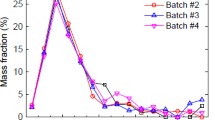Abstract
An experimental study has been conducted to elucidate the mechanism of radial segregation in the bed of a rotary kiln and to determine the size and composition of the segregated core. Bed-behavior diagrams were obtained, and slumping and rolling characteristics were measured, for two sand mixtures and one limestone mixture containing fines. The fines resulted in significant changes in bed behavior, but no effects were observed on either static or dynamic angle of repose, shear angle, slumping frequency, or active-layer thickness. Therefore it was concluded that the fines do not segregate according to the differential flow of particles down the surface of the bed. Instead percolation, in which the fines pass through the voids in the coarser solids, appears to be the operative mechanism. The size of the segregated core was measured by sampling the bed of solids. Predictions of core width based on geometric considerations and a core composition having the minimum void fraction agreed reasonably well with measurements. A second region of segregation was found adjacent to the wall. The two zones of segregation can influence deleteriously kiln performance. Solids in the central core are not exposed to the hot freeboard gases and therefore may only partially react. The zone of fines at the kiln wall can reduce wall/bed friction to the extent that the bed slips against the wall.
Similar content being viewed by others
Abbreviations
- a′:
-
active layer thickness
- d p :
-
particle size
- g :
-
gravitational acceleration constant
- w k :
-
width of central segregated core
- x :
-
weight fraction of the fine dimensionless component in the slice
- y :
-
weight fraction of the coarse dimensionless component in the central segregated core
- A:
-
cross-sectional area of the bed
- Fr:
-
Froude number (ω2R/g) dimensionless
- H :
-
depth of the bulk solids in therotary cylinder or rotary kiln
- L :
-
length of rotary cylinder or rotary kiln
- R :
-
inside radius of the cylinder
- R K :
-
outer radius of rotation of the central core of segregation
- V K :
-
volume occupied by the bulk solids that is associated with the central core of segregation
- W K :
-
total weight of bulk solids kg associated with the central core of segregation
- W T :
-
Total weight of bulk solids in the bed
- ε:
-
void fraction of the bulk solids
- δεmax :
-
maximum bed contraction
- ρB K :
-
bulk density of central core of segregation
- ω:
-
angular velocity of the rotary cylinder
References
G. Reuter: Doctoral Thesis, Rheinisch-Westfalischen Technischen Hochschule Aachen, Aachen, Germany, October 1975.
K.W. Carley-Macauly and M.B. Donald:Chemical Engineering Science, 1962, vol. 17, pp. 493–506.
C. E. Sunnergren: National Lime Association Operators Meeting, Seattle, WA, September 24, 1979.
Fr. Muller: Aufbereitungs-Technik, 1966, vol. 5, pp. 274–85.
A.M. Gow, A.B. Campbell, and W. H. Coghill:AIME, 1930, vol. 87, pp. 51–81.
M. Wahlster, H. G. Jost, H. Serbent, and G. Meyer:Techn. Mitt. Krupp (forsch.-Ber.), 1963, vol. 21, no. 1, pp. 5–14.
K. Yamaguchi:Seramikkusu, 1971, vol. 6, no. 1, pp. 47–54.
M.B. Donald and B. Roseman:Brit. Chem. Eng., 1962, vol. 7, no. 10, pp. 749–53.
W. Weydans:Chem. Ing. Tech., 1960, vol. 32, pp. 343–49.
Von C. Sauer:Neue Hutte, 1972, vol. 17, no. 6, pp. 358–62.
M. Ullrich:Chemie. Ing.-Techn., 1969, vol. 41, no. 16, pp. 903–07.
A.R. Rogers and J. A. Clements:Powder Technology, 1971/72, vol. 5, pp. 167–78.
S. S. Weidenbaum:Advances in Chemical Engineering, 1958, vol. 2, pp. 209–324.
S. S. Weidenbaum and C. F. Bonilla:Chemical Engineering Progress, 1955, vol. 51, no. 1, pp. 27.J-36.J.
B. Roseman and M.B. Donald:Brit. Chem. Eng., 1962, vol. 7, no. 11, pp. 823–27.
J.M. Coulson and N.K. Maitra:The Industrial Chemist, 1950, vol. 26, pp. 55–60.
M.B. Donald and B. Roseman:Brit. Chem. Eng., 1962, vol. 7, no. 12, pp. 922–23.
C.E. Sunnergren: Bethlehem Steel Corp., Bethlehem, PA, unpublished research, 1980.
J.C. Richards: I. Chem. E. Working Party Report, 1966.
J.C. Williams and M.I. Khan:The Chemical Engineer, 1973, pp. 19–25.
H. Henein, J. K. Brimacombe, and A. P. Watkinson:Metall. Trans. B, 1983, vol. 14B, pp. 191–205.
H. Henein: Ph.D. Thesis, The University of British Columbia, Vancouver, BC 1981.
.Henein, N. Nityanand, and B. Manley:Metall. Trans. B, to be published.
A. Vaillant: Ph.D. Thesis, Columbia University, New York, NY, 1965.
N. Nityanand:unpublished research, Carnegie-Mellon University, Pittsburgh, PA, 1984.
J. Eastwood, E. J. P. Matzen, M. J. Young, and N. Epstein:British Chem. Eng., Nov. 1969, vol. 14, 11 pp. 1542–45.
Author information
Authors and Affiliations
Additional information
Formerly Graduate Student, Department of Metallur-gical Engineering, The University of British Columbia
Rights and permissions
About this article
Cite this article
Henein, H., Brimacombe, J.K. & Watkinson, A.P. An experimental study of segregation in rotary kilns. Metall Trans B 16, 763–774 (1985). https://doi.org/10.1007/BF02667512
Received:
Issue Date:
DOI: https://doi.org/10.1007/BF02667512




